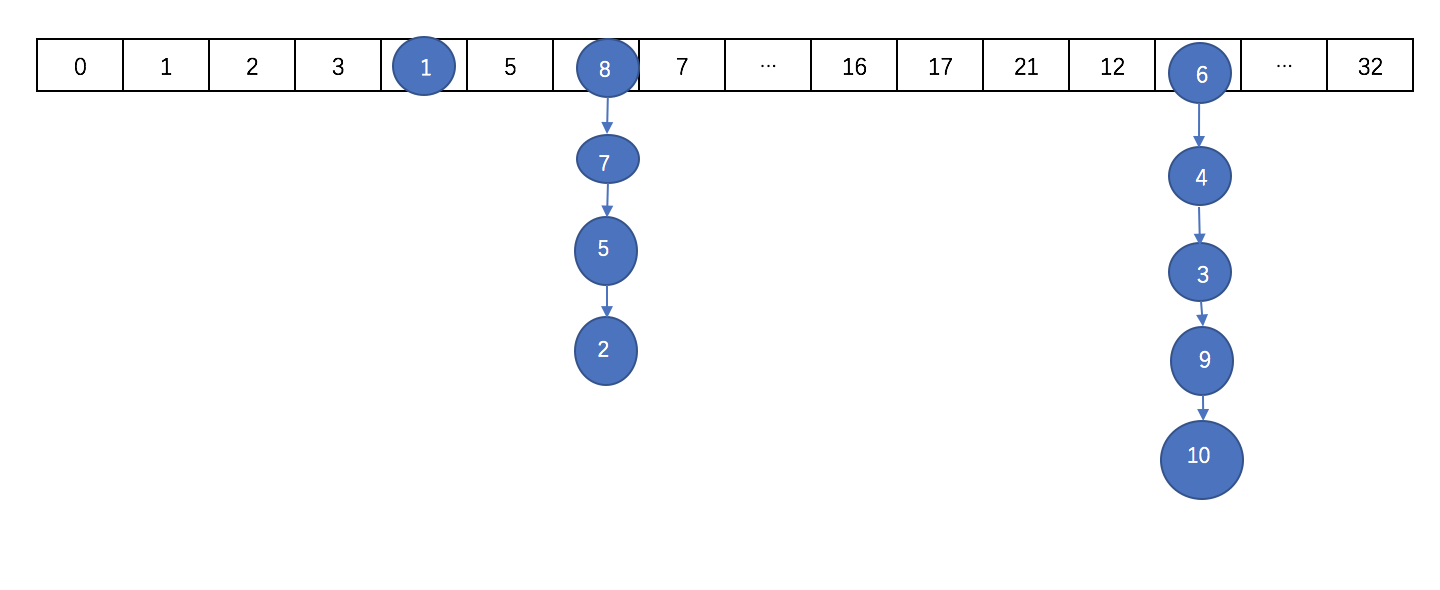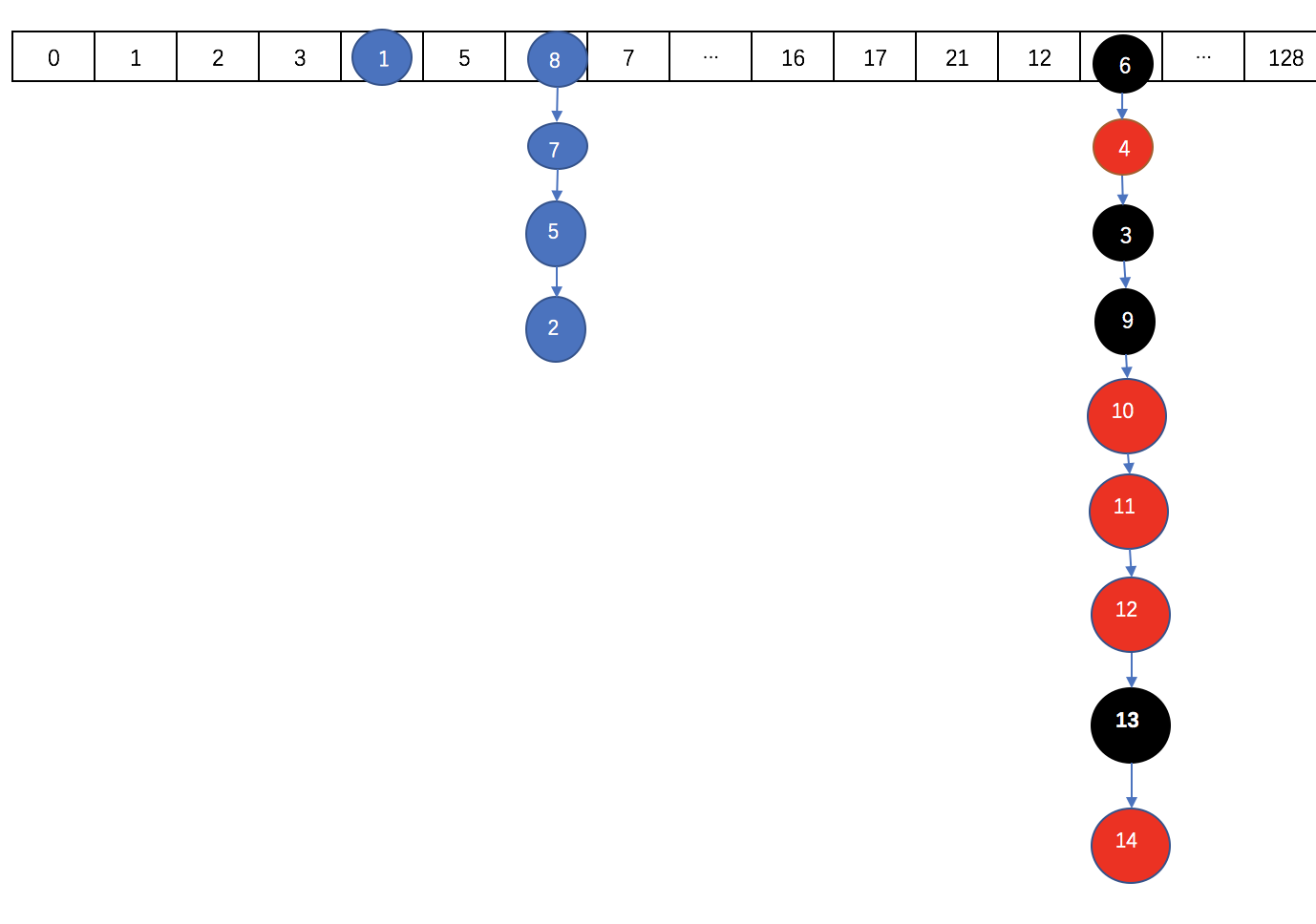ConcurrentHashMap跟HashMap,HashTable的对比 我们都知道HashMap不是线程安全的,所以在处理并发的时候会出现问题。
而HashTable虽然是线程安全的,但是是通过整个来加锁的方式,当一个线程在写操作的时候,另外的线程则不能进行读写。
而ConcurrentHashMap则可以支持并发的读写。跟1.7版本相比,1.8版本又有了很大的变化,已经抛弃了Segment的概念,虽然源码里面还保留了,也只是为了兼容性的考虑。
ConcurrentHashMap原理概览 在ConcurrentHashMap中通过一个Node<K,V>[]数组来保存添加到map中的键值对,而在同一个数组位置是通过链表和红黑树的形式来保存的。但是这个数组只有在第一次添加元素的时候才会初始化,否则只是初始化一个ConcurrentHashMap对象的话,只是设定了一个sizeCtl变量,这个变量用来判断对象的一些状态和是否需要扩容,后面会详细解释。
第一次添加元素的时候,默认初期长度为16,当往map中继续添加元素的时候,通过hash值跟数组长度取与来决定放在数组的哪个位置,如果出现放在同一个位置的时候,优先以链表的形式存放,在同一个位置的个数又达到了8个以上,如果数组的长度还小于64的时候,则会扩容数组。如果数组的长度大于等于64了的话,在会将该节点的链表转换成树。
通过扩容数组的方式来把这些节点给分散开。然后将这些元素复制到扩容后的新的数组中,同一个链表中的元素通过hash值的数组长度位来区分,是还是放在原来的位置还是放到扩容的长度的相同位置去 。在扩容完成之后,如果某个节点的是树,同时现在该节点的个数又小于等于6个了,则会将该树转为链表。
取元素的时候,相对来说比较简单,通过计算hash来确定该元素在数组的哪个位置,然后在通过遍历链表或树来判断key和key的hash,取出value值。
往ConcurrentHashMap中添加元素的时候,里面的数据以数组的形式存放的样子大概是这样的:
这个时候因为数组的长度才为16,则不会转化为树,而是会进行扩容。
扩容后数组大概是这样的:
需要注意的是,扩容之后的长度不是32,扩容后的长度在后面细说。
如果数组扩张后长度达到64了,且继续在某个节点的后面添加元素达到8个以上的时候,则会出现转化为红黑树的情况。
转化之后大概是这样:
ConcurrentHashMap几个重要概念 1 2 3 4 5 6 7 8 9 10 11 12 13 14 15 16 17 18 private static final int MAXIMUM_CAPACITY = 1 << 30 ;private static final int DEFAULT_CAPACITY = 16 ;static final int TREEIFY_THRESHOLD = 8 ;static final int UNTREEIFY_THRESHOLD = 6 ;static final int MIN_TREEIFY_CAPACITY = 64 ;static final int MOVED = -1 ; static final int TREEBIN = -2 ; static final int RESERVED = -3 ; static final int HASH_BITS = 0x7fffffff ; transient volatile Node<K,V>[] table;private transient volatile Node<K,V>[] nextTable; private transient volatile int sizeCtl;
几个重要的类
Node<K,V>,这是构成每个元素的基本类。
1 2 3 4 5 6 7 8 9 10 11 12 13 14 15 16 static class Node <K ,V > implements Map .Entry <K ,V > final int hash; final K key; volatile V val; volatile Node<K,V> next; Node(int hash, K key, V val, Node<K,V> next) { this .hash = hash; this .key = key; this .val = val; this .next = next; } public final K getKey () return key; } public final V getValue () return val; } public final int hashCode () return key.hashCode() ^ val.hashCode(); } }
TreeNode,构造树的节点
1 2 3 4 5 6 7 8 9 10 11 12 13 static final class TreeNode <K ,V > extends Node <K ,V > TreeNode<K,V> parent; TreeNode<K,V> left; TreeNode<K,V> right; TreeNode<K,V> prev; boolean red; TreeNode(int hash, K key, V val, Node<K,V> next, TreeNode<K,V> parent) { super (hash, key, val, next); this .parent = parent; } }
TreeBin 用作树的头结点,只存储root和first节点,不存储节点的key、value值。
1 2 3 4 5 6 7 8 9 10 static final class TreeBin <K ,V > extends Node <K ,V > TreeNode<K,V> root; volatile TreeNode<K,V> first; volatile Thread waiter; volatile int lockState; static final int WRITER = 1 ; static final int WAITER = 2 ; static final int READER = 4 ; }
ForwardingNode在转移的时候放在头部的节点,是一个空节点
1 2 3 4 5 6 static final class ForwardingNode <K ,V > extends Node <K ,V > final Node<K,V>[] nextTable; ForwardingNode(Node<K,V>[] tab) { super (MOVED, null , null , null ); this .nextTable = tab; }}
ConcurrentHashMap的初始化 构造方法
1 2 3 4 5 6 7 8 9 10 11 12 13 14 15 16 17 public ConcurrentHashMapDebug () } public ConcurrentHashMapDebug (int initialCapacity) if (initialCapacity < 0 ) throw new IllegalArgumentException(); int cap = ((initialCapacity >= (MAXIMUM_CAPACITY >>> 1 )) ? MAXIMUM_CAPACITY : tableSizeFor(initialCapacity + (initialCapacity >>> 1 ) + 1 )); this .sizeCtl = cap; } public ConcurrentHashMapDebug (Map<? extends K, ? extends V> m) this .sizeCtl = DEFAULT_CAPACITY; putAll(m); }
可以看到,在任何一个构造方法中,都没有对存储Map元素Node的table变量进行初始化。而是在第一次put操作的时候在进行初始化。
下面来看看数组的初始化方法initTable
1 2 3 4 5 6 7 8 9 10 11 12 13 14 15 16 17 18 19 20 21 22 23 24 25 26 27 28 29 private final Node<K,V>[] initTable() { Node<K,V>[] tab; int sc; while ((tab = table) == null || tab.length == 0 ) { if ((sc = sizeCtl) < 0 ) Thread.yield(); else if (U.compareAndSwapInt(this , SIZECTL, sc, -1 )) { try { if ((tab = table) == null || tab.length == 0 ) { int n = (sc > 0 ) ? sc : DEFAULT_CAPACITY; @SuppressWarnings("unchecked") Node<K,V>[] nt = (Node<K,V>[])new Node<?,?>[n]; table = tab = nt; sc = n - (n >>> 2 ); } } finally { sizeCtl = sc; } break ; } } return tab; }
ConcurrentHashMap的put操作详解 下面看看put方法的源码
1 2 3 4 5 6 7 8 public V put (K key, V value) return putVal(key, value, false ); }
再来看putVal
1 2 3 4 5 6 7 8 9 10 11 12 13 14 15 16 17 18 19 20 21 22 23 24 25 26 27 28 29 30 31 32 33 34 35 36 37 38 39 40 41 42 43 44 45 46 47 48 49 50 51 52 53 54 55 56 57 58 59 60 61 62 63 64 65 66 67 68 69 70 71 72 73 74 75 76 77 78 79 80 81 82 83 84 85 86 87 88 89 90 91 final V putVal (K key, V value, boolean onlyIfAbsent) if (key == null || value == null ) throw new NullPointerException(); int hash = spread(key.hashCode()); int binCount = 0 ; for (Node<K,V>[] tab = table;;) { Node<K,V> f; int n, i, fh; if (tab == null || (n = tab.length) == 0 ) tab = initTable(); else if ((f = tabAt(tab, i = (n - 1 ) & hash)) == null ) { if (casTabAt(tab, i, null , new Node<K,V>(hash, key, value, null ))) break ; } else if ((fh = f.hash) == MOVED) tab = helpTransfer(tab, f); else { V oldVal = null ; synchronized (f) { if (tabAt(tab, i) == f) { if (fh >= 0 ) { binCount = 1 ; for (Node<K,V> e = f;; ++binCount) { K ek; if (e.hash == hash && ((ek = e.key) == key || (ek != null && key.equals(ek)))) { oldVal = e.val; if (!onlyIfAbsent) e.val = value; break ; } Node<K,V> pred = e; if ((e = e.next) == null ) { pred.next = new Node<K,V>(hash, key, value, null ); break ; } } } else if (f instanceof TreeBin) { Node<K,V> p; binCount = 2 ; if ((p = ((TreeBin<K,V>)f).putTreeVal(hash, key, value)) != null ) { oldVal = p.val; if (!onlyIfAbsent) p.val = value; } } } } if (binCount != 0 ) { if (binCount >= TREEIFY_THRESHOLD) treeifyBin(tab, i); if (oldVal != null ) return oldVal; break ; } } } addCount(1L , binCount); return null ; }
ConcurrentHashMap的扩容详解 在put方法的详解中,我们可以看到,在同一个节点的个数超过8个的时候,会调用treeifyBin方法来看看是扩容还是转化为一棵树
同时在每次添加完元素的addCount方法中,也会判断当前数组中的元素是否达到了sizeCtl的量,如果达到了的话,则会进入transfer方法去扩容
1 2 3 4 5 6 7 8 9 10 11 12 13 14 15 16 17 18 19 20 21 22 23 24 25 26 27 28 29 30 31 private final void treeifyBin (Node<K,V>[] tab, int index) Node<K,V> b; int n, sc; if (tab != null ) { System.out.println("treeifyBin方\t==>数组长:" +tab.length); if ((n = tab.length) < MIN_TREEIFY_CAPACITY) tryPresize(n << 1 ); else if ((b = tabAt(tab, index)) != null && b.hash >= 0 ) { synchronized (b) { if (tabAt(tab, index) == b) { TreeNode<K,V> hd = null , tl = null ; for (Node<K,V> e = b; e != null ; e = e.next) { TreeNode<K,V> p = new TreeNode<K,V>(e.hash, e.key, e.val, null , null ); if ((p.prev = tl) == null ) hd = p; else tl.next = p; tl = p; } setTabAt(tab, index, new TreeBin<K,V>(hd)); } } } } }
可以看到当需要扩容的时候,调用的时候tryPresize方法,看看trePresize的源码
1 2 3 4 5 6 7 8 9 10 11 12 13 14 15 16 17 18 19 20 21 22 23 24 25 26 27 28 29 30 31 32 33 34 35 36 37 38 39 40 41 42 43 44 45 46 47 48 49 50 51 52 53 54 55 56 57 58 59 60 61 62 63 64 65 66 67 68 69 70 71 72 73 74 75 76 77 78 79 80 81 82 private final void tryPresize (int size) int c = (size >= (MAXIMUM_CAPACITY >>> 1 )) ? MAXIMUM_CAPACITY : tableSizeFor(size + (size >>> 1 ) + 1 ); int sc; while ((sc = sizeCtl) >= 0 ) { Node<K,V>[] tab = table; int n; if (tab == null || (n = tab.length) == 0 ) { n = (sc > c) ? sc : c; if (U.compareAndSwapInt(this , SIZECTL, sc, -1 )) { try { if (table == tab) { @SuppressWarnings("unchecked") Node<K,V>[] nt = (Node<K,V>[])new Node<?,?>[n]; table = nt; sc = n - (n >>> 2 ); } } finally { sizeCtl = sc; } } } else if (c <= sc || n >= MAXIMUM_CAPACITY) { break ; } else if (tab == table) { int rs = resizeStamp(n); if (sc < 0 ) { Node<K,V>[] nt; if ((sc >>> RESIZE_STAMP_SHIFT) != rs || sc == rs + 1 || sc == rs + MAX_RESIZERS || (nt = nextTable) == null || transferIndex <= 0 ) break ; if (U.compareAndSwapInt(this , SIZECTL, sc, sc + 1 )) transfer(tab, nt); } else if (U.compareAndSwapInt(this , SIZECTL, sc, (rs << RESIZE_STAMP_SHIFT) + 2 )) { transfer(tab, null ); } } } }
在tryPresize方法中,并没有加锁,允许多个线程进入,如果数组正在扩张,则当前线程也去帮助扩容。
数组扩容的主要方法就是transfer方法
1 2 3 4 5 6 7 8 9 10 11 12 13 14 15 16 17 18 19 20 21 22 23 24 25 26 27 28 29 30 31 32 33 34 35 36 37 38 39 40 41 42 43 44 45 46 47 48 49 50 51 52 53 54 55 56 57 58 59 60 61 62 63 64 65 66 67 68 69 70 71 72 73 74 75 76 77 78 79 80 81 82 83 84 85 86 87 88 89 90 91 92 93 94 95 96 97 98 99 100 101 102 103 104 105 106 107 108 109 110 111 112 113 114 115 116 117 118 119 120 121 122 123 124 125 126 127 128 129 130 131 132 133 134 135 136 137 138 139 140 141 142 143 144 145 146 147 148 149 150 151 152 153 154 155 156 157 158 159 160 161 162 163 164 165 166 167 168 169 170 171 172 173 174 175 176 177 178 179 180 181 182 183 184 185 186 187 private final void transfer (Node<K,V>[] tab, Node<K,V>[] nextTab) int n = tab.length, stride; if ((stride = (NCPU > 1 ) ? (n >>> 3 ) / NCPU : n) < MIN_TRANSFER_STRIDE) stride = MIN_TRANSFER_STRIDE; if (nextTab == null ) { try { @SuppressWarnings("unchecked") Node<K,V>[] nt = (Node<K,V>[])new Node<?,?>[n << 1 ]; nextTab = nt; } catch (Throwable ex) { sizeCtl = Integer.MAX_VALUE; return ; } nextTable = nextTab; transferIndex = n; } int nextn = nextTab.length; ForwardingNode<K,V> fwd = new ForwardingNode<K,V>(nextTab); boolean advance = true ; boolean finishing = false ; for (int i = 0 , bound = 0 ;;) { Node<K,V> f; int fh; while (advance) { int nextIndex, nextBound; if (--i >= bound || finishing) { advance = false ; } else if ((nextIndex = transferIndex) <= 0 ) { i = -1 ; advance = false ; } else if (U.compareAndSwapInt (this , TRANSFERINDEX, nextIndex, nextBound = (nextIndex > stride ? nextIndex - stride : 0 ))) { bound = nextBound; i = nextIndex - 1 ; advance = false ; } } if (i < 0 || i >= n || i + n >= nextn) { int sc; if (finishing) { nextTable = null ; table = nextTab; sizeCtl = (n << 1 ) - (n >>> 1 ); return ; } if (U.compareAndSwapInt(this , SIZECTL, sc = sizeCtl, sc - 1 )) { if ((sc - 2 ) != resizeStamp(n) << RESIZE_STAMP_SHIFT) { return ; } finishing = advance = true ; i = n; } } else if ((f = tabAt(tab, i)) == null ) advance = casTabAt(tab, i, null , fwd); else if ((fh = f.hash) == MOVED) advance = true ; else { synchronized (f) { if (tabAt(tab, i) == f) { Node<K,V> ln, hn; if (fh >= 0 ) { int runBit = fh & n; Node<K,V> lastRun = f; for (Node<K,V> p = f.next; p != null ; p = p.next) { int b = p.hash & n; if (b != runBit) { runBit = b; lastRun = p; } } if (runBit == 0 ) { ln = lastRun; hn = null ; } else { hn = lastRun; ln = null ; } for (Node<K,V> p = f; p != lastRun; p = p.next) { int ph = p.hash; K pk = p.key; V pv = p.val; if ((ph & n) == 0 ) ln = new Node<K,V>(ph, pk, pv, ln); else hn = new Node<K,V>(ph, pk, pv, hn); } setTabAt(nextTab, i, ln); setTabAt(nextTab, i + n, hn); setTabAt(tab, i, fwd); advance = true ; } else if (f instanceof TreeBin) { TreeBin<K,V> t = (TreeBin<K,V>)f; TreeNode<K,V> lo = null , loTail = null ; TreeNode<K,V> hi = null , hiTail = null ; int lc = 0 , hc = 0 ; for (Node<K,V> e = t.first; e != null ; e = e.next) { int h = e.hash; TreeNode<K,V> p = new TreeNode<K,V> (h, e.key, e.val, null , null ); if ((h & n) == 0 ) { if ((p.prev = loTail) == null ) lo = p; else loTail.next = p; loTail = p; ++lc; } else { if ((p.prev = hiTail) == null ) hi = p; else hiTail.next = p; hiTail = p; ++hc; } } ln = (lc <= UNTREEIFY_THRESHOLD) ? untreeify(lo) : (hc != 0 ) ? new TreeBin<K,V>(lo) : t; hn = (hc <= UNTREEIFY_THRESHOLD) ? untreeify(hi) : (lc != 0 ) ? new TreeBin<K,V>(hi) : t; setTabAt(nextTab, i, ln); setTabAt(nextTab, i + n, hn); setTabAt(tab, i, fwd); advance = true ; } } } } } }
到这里,ConcurrentHashMap的put操作和扩容都介绍的差不多了,
下面的两点一定要注意:
ConcurrentHashMap的get操作详解 相比put操作,get操作就显得很简单了。废话少说,直接上源码分析。
1 2 3 4 5 6 7 8 9 10 11 12 13 14 15 16 17 18 19 20 21 22 23 24 25 26 public V get (Object key) Node<K,V>[] tab; Node<K,V> e, p; int n, eh; K ek; int h = spread(key.hashCode()); if ((tab = table) != null && (n = tab.length) > 0 && (e = tabAt(tab, (n - 1 ) & h)) != null ) { if ((eh = e.hash) == h) { if ((ek = e.key) == key || (ek != null && key.equals(ek))) return e.val; } else if (eh < 0 ) return (p = e.find(h, key)) != null ? p.val : null ; while ((e = e.next) != null ) { if (e.hash == h && ((ek = e.key) == key || (ek != null && key.equals(ek)))) return e.val; } } return null ; }
总结 前面分析了下ConcurrentHashMap的源码,那么,对于一个映射集合来说,ConcurrentHashMap是如果来做到并发安全,又是如何做到高效的并发的呢?
首先是读操作,从源码中可以看出来,在get操作中,根本没有使用同步机制,也没有使用unsafe方法,所以读操作是支持并发操作的。
那么写操作呢?
分析这个之前,先看看什么情况下会引起数组的扩容,扩容是通过transfer方法来进行的。而调用transfer方法的只有trePresize、helpTransfer和addCount三个方法。
这三个方法又是分别在什么情况下进行调用的呢?
tryPresize是在treeIfybin和putAll方法中调用,treeIfybin主要是在put添加元素完之后,判断该数组节点相关元素是不是已经超过8个的时候,如果超过则会调用这个方法来扩容数组或者把链表转为树。
helpTransfer是在当一个线程要对table中元素进行操作的时候,如果检测到节点的HASH值为MOVED的时候,就会调用helpTransfer方法,在helpTransfer中再调用transfer方法来帮助完成数组的扩容
addCount是在当对数组进行操作,使得数组中存储的元素个数发生了变化的时候会调用的方法。
所以引起数组扩容的情况如下 :
只有在往map中添加元素的时候,在某一个节点的数目已经超过了8个,同时数组的长度又小于64的时候,才会触发数组的扩容。
当数组中元素达到了sizeCtl的数量的时候,则会调用transfer方法来进行扩容
那么在扩容的时候,可以不可以对数组进行读写操作呢?
事实上是可以的。当在进行数组扩容的时候,如果当前节点还没有被处理(也就是说还没有设置为fwd节点),那就可以进行设置操作。
如果该节点已经被处理了,则当前线程也会加入到扩容的操作中去。
那么,多个线程又是如何同步处理的呢?
在ConcurrentHashMap中,同步处理主要是通过Synchronized和unsafe两种方式来完成的。
在取得sizeCtl、某个位置的Node的时候,使用的都是unsafe的方法,来达到并发安全的目的
当需要在某个位置设置节点的时候,则会通过Synchronized的同步机制来锁定该位置的节点。
在数组扩容的时候,则通过处理的步长和fwd节点来达到并发安全的目的,通过设置hash值为MOVED
当把某个位置的节点复制到扩张后的table的时候,也通过Synchronized的同步机制来保证现程安全










